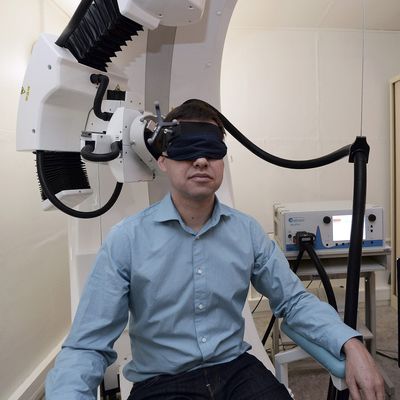
Many people are excited about the prospect of using electricity or magnetism to “hack” the human brain. While the science is pretty new, the notion of targeting the brain with electrical stimulation or a magnetic field in the hopes of boosting cognitive performance — or ameliorating a deficit — has led to both mainstream research interest and some weird internet subculture of DIY brain-zappers. Among other intriguing early findings in this field, researchers have found that if you stimulate certain parts of someone’s brain with so-called transcranial direct current stimulation (tDCS), it seems to offer at least a short-term boost to their language abilities.
Now, a new study in the Journal of Neuroscience helps point the way toward a future in which so-called “high-definition” tDCS could help people overcome learning deficits induced by brain trauma or other misfortune.
HD-tDCS, the paper’s authors note, “allows for the application of relatively focal current stimulation [on one particular area of the brain] by using a circumscribed array of scalp electrodes,” allowing researchers to apply a current to a much more specific part of the brain than “traditional” tDCS. (For short, I’ll refer to the researchers’ technique as “tDCS” throughout the article, but when I do I’m referring to their high-def flavor of it.)
“The goal of this study was to understand the function of a particular brain region — the angular gyrus [AG],” said Amy Rose Price, a graduate student in neuroscience at the University of Pennsylvania and the paper’s lead author, in an email. “We know that this brain region contributes to many cognitive processes that are highly advanced in humans relative to other animals, such as semantic memory, episodic memory, theory of mind, moral cognition, and symbolic communication (i.e., language). We also know that during the evolution of the human brain this region has expanded dramatically relative to the brains of other primates.
“So all the signs point to this region performing a really important high-level function in human cognition, but we’re still trying to understand the complexities of what it’s specifically doing,” she continued. One theory, she explained, is that the AG plays an important role in “semantic integration,” the process by which “words in a sentence are integrated into a more complex idea than could be conveyed by any single word alone.”
So she and her colleagues decided to test whether stimulating the AG would give their study participants a boost in their semantic integration skills. For the study, they hooked up 18 participants to a tDCS device. Then, they had them participate in two tasks, a “letter-string control task” in which they had to press a button to indicate whether or not a pair of nonsense strings of letters matched, and, more importantly, a “word-pair task.”
In the word-pair task, the participants were presented with a series of, well, word pairs, and asked to decide whether or not the pair made sense (to take two examples from the study, “tiny radish” makes sense, “fast blueberry” doesn’t). The task was completed under three conditions: one in which the AG was stimulated; another in which “sham” stimulation — that is, no actual stimulation — took place, which could cause a placebo effect; and a third in which an unrelated part of the participant’s brain was stimulated.
The results suggested that the AG does, in fact, play a role in semantic integration. Specifically, the stimulation “resulted in faster comprehension of semantically meaningful combinations like ‘tiny radish’ relative to non-meaningful combinations, such as ‘fast blueberry,’ when compared to the effects observed during sham stimulation and stimulation to a right-hemisphere control brain region,” as the study abstract puts it. The electrical current seemed to put into overdrive — in a modest way, given the time differences in question — participants’ ability to determine whether the word combinations had meaning.
It’s an intriguing finding that helps researchers zero in on the parts of the brain most responsible for the a vital cognitive ability that helps make humans humans. It also, Price said in her email, offers a glimpse at what these sorts of techniques might be capable of in the future. Her study only dealt with reaction time, but this sort of research could just be one step in the path toward an exciting new array of treatments that offer more concrete benefits. “When I think of tDCS as a potential therapy or as a potential means for cognitive enhancement, I’m thinking of more drastic effects on behavior, such as an aphasic patient beginning to comprehend things that they previously had difficulty understanding,” she said. “These are the kinds of potential applications that will need further work to figure out” [link added].
She was clear, though, that this is not the sort of technology that neuroscientists will be dropping on society’s doorstep tomorrow — they have a ways to go first. The research conducted so far, including Price’s study, focuses primarily on “transient” effects — on how brain stimulation affects someone in the immediate short term. “Much less is known about how repeated brain stimulation sessions, across many days, affect the brain,” said Price. “For example, after how many sessions do the effects from stimulation plateau? And can we achieve long-lasting effects from multiple sessions? These are the kinds of questions that we hope to address in future work.”
And while those questions are being answered, Price said, she’d caution people against participating in the burgeoning field of DIY brain stimulation, or signing up for commercial procedures that make strong claims on this front. “There need to be many more studies tracking the long-term effects of prolonged and repeated sessions of tDCS,” she said, and until there are, she said she doesn’t “think there is enough evidence out there that healthy people should be using brain stimulation at home to achieve ‘better’ cognitive abilities.” If only there were a brain-stimulation device that could make people more patient.




